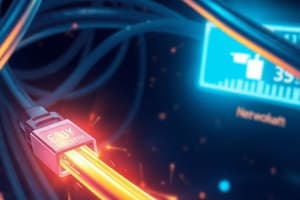Podcast
Questions and Answers
What is the term used to measure the transfer of usable data over a given period of time?
What is the term used to measure the transfer of usable data over a given period of time?
- Throughput
- Latency
- Goodput (correct)
- Bandwidth
What is one of the primary reasons for using copper cabling in networks?
What is one of the primary reasons for using copper cabling in networks?
- It allows for unlimited distance transmission
- It has high resistance to electrical current
- It is less prone to electromagnetic interference
- It is inexpensive and easy to install (correct)
What is the effect called when a signal deteriorates as it travels farther over copper cables?
What is the effect called when a signal deteriorates as it travels farther over copper cables?
- Goodput
- Interference
- Attenuation (correct)
- Crosstalk
Which type of interference can distort data signals on copper media?
Which type of interference can distort data signals on copper media?
What do the traffic overhead factors in goodput measurement include?
What do the traffic overhead factors in goodput measurement include?
What type of cable is used to connect similar devices directly, such as two computers or two switches?
What type of cable is used to connect similar devices directly, such as two computers or two switches?
Which type of cable is considered Cisco proprietary and is mainly used for configuration purposes?
Which type of cable is considered Cisco proprietary and is mainly used for configuration purposes?
What feature of fiber-optic cabling allows it to transmit data over longer distances compared to copper wiring?
What feature of fiber-optic cabling allows it to transmit data over longer distances compared to copper wiring?
Which statement best describes Ethernet Straight-Through Cables?
Which statement best describes Ethernet Straight-Through Cables?
What is a common troubleshooting step if connectivity is not achieved between devices?
What is a common troubleshooting step if connectivity is not achieved between devices?
What is the main purpose of twisting the wires in unshielded twisted-pair (UTP) cabling?
What is the main purpose of twisting the wires in unshielded twisted-pair (UTP) cabling?
What is one drawback of shielded twisted-pair (STP) cables compared to UTP cables?
What is one drawback of shielded twisted-pair (STP) cables compared to UTP cables?
What contributes to crosstalk reduction in copper cables?
What contributes to crosstalk reduction in copper cables?
What is the main function of the braided copper layer in coaxial cable?
What is the main function of the braided copper layer in coaxial cable?
How can improper grounding of STP cables affect their performance?
How can improper grounding of STP cables affect their performance?
What is the primary function of twisting wire pairs in UTP cables?
What is the primary function of twisting wire pairs in UTP cables?
Which standard governs commercial cabling standards for LAN installations?
Which standard governs commercial cabling standards for LAN installations?
What is the minimum acceptable cable type for new gigabit speed Ethernet installations?
What is the minimum acceptable cable type for new gigabit speed Ethernet installations?
Which category of UTP cable is designed to support speeds up to 10 Gbps?
Which category of UTP cable is designed to support speeds up to 10 Gbps?
What type of UTP cable is most commonly used to connect a host to a switch?
What type of UTP cable is most commonly used to connect a host to a switch?
Which category of cable was originally used for voice communication before being adapted for data transmission?
Which category of cable was originally used for voice communication before being adapted for data transmission?
What feature distinguishes Category 6 cables from those in lower categories?
What feature distinguishes Category 6 cables from those in lower categories?
What is the main purpose of wiring conventions in UTP cables?
What is the main purpose of wiring conventions in UTP cables?
Which of the following categories of cabling is NOT typically used for supporting 1000 Mbps?
Which of the following categories of cabling is NOT typically used for supporting 1000 Mbps?
Why do some manufacturers refer to cables exceeding TIA/EIA Category 6a specifications as Category 7?
Why do some manufacturers refer to cables exceeding TIA/EIA Category 6a specifications as Category 7?
Flashcards are hidden until you start studying
Study Notes
Factors Influencing Throughput
- Throughput is affected by the volume and type of network traffic.
- Latency introduced by multiple network devices between source and destination impacts throughput.
Goodput
- Goodput measures usable data transferred over time, calculated as throughput minus traffic overhead.
- Goodput is always lower than throughput, which is in turn lower than the bandwidth.
Copper Cabling
- The most common cabling used in networks includes three types, selected for specific applications.
- Advantages of copper cabling: cost-effective, easy installation, low electrical resistance.
- Limitations include distance restrictions and susceptibility to signal interference.
Signal Attenuation
- Signals degrade over distance, leading to signal attenuation.
- Successful signal reception requires proper decoding at the destination device.
Types of Interference
- Electromagnetic Interference (EMI) / Radio Frequency Interference (RFI): Distorts data signals, originating from devices like electric motors.
- Crosstalk: Occurs when electric or magnetic fields from one wire affect another wire, causing signal disturbances.
Mitigating Interference
- Copper cables can mitigate EMI/RFI effects using metallic shielding and grounding.
- Twisted pairs reduce crosstalk through opposing wire pair designs.
- Recommendations include choosing suitable cable categories, designing infrastructure wisely, and proper cable handling.
Unshielded Twisted Pair (UTP)
- UTP is the most commonly used networking media and connects devices like computers, switches, and routers.
- Consists of four pairs of twisted wires encased in plastic, minimizing interference.
Shielded Twisted Pair (STP)
- STP provides better noise protection compared to UTP but comes at a higher cost and complexity.
- Uses shielding techniques against EMI/RFI, requiring careful grounding to avoid unwanted signals.
Coaxial Cable
- Coaxial cable features a central copper conductor, plastic insulation, and a woven copper braid for shielding.
- UTP cable relies on twisted pairs for self-shielding, while coaxial has built-in shielding.
TIA/EIA Standards
- TIA/EIA-568 outlines commercial cabling standards for LAN installations, detailing cable types, lengths, connectors, terminations, and testing methods.
Cable Categories
- Cables are categorized by bandwidth capacity:
- Category 5 supports 100 Mbps; Category 5e supports 1000 Mbps.
- Category 6 supports up to 10 Gbps; Category 7 supports 10 Gbps; Category 8 supports 40 Gbps.
- Higher categories are designed for increased data rates and performance.
Wiring Conventions
- Ethernet Straight-through Cable: Connect different devices, such as computer to switch.
- Ethernet Crossover Cable: Connect similar devices, like switch to switch.
- Cisco Rollover Cable: Connects a computer terminal to a Cisco router/switch console for configuration.
Fiber-Optic Cabling
- Fiber-optic cabling offers longer distances and higher bandwidth than copper, immune to electrical interference.
- It uses glass strands to transmit data as light impulses, minimizing signal loss.
Types of Fiber-Optic Cable
- Single-Mode Fiber (SMF): Lower dispersion, can travel longer distances with minimal loss.
- Multimode Fiber (MMF): Higher dispersion, limited to around 500 meters due to signal loss.
Applications of Fiber-Optic Cabling
- Enterprise Networks: Backbone applications and infrastructure device interconnectivity.
- Fiber-to-the-Home (FTTH): Broadband services for homes and small businesses.
- Long-Haul Networks: Connects large distances for service providers.
- Submarine Cable Networks: Provides high-speed, reliable connections in harsh underwater environments.
Optical-Fiber Connectors
- Variety of connectors based on dimensions and coupling methods, selected according to equipment needs.
- Light traditionally traveled unidirectionally; duplex connectors allow dual-direction capability in a single connector.
Standards for Fiber Use
- BX standards utilize different wavelengths for transmitting and receiving over a single fiber cable.
Studying That Suits You
Use AI to generate personalized quizzes and flashcards to suit your learning preferences.




